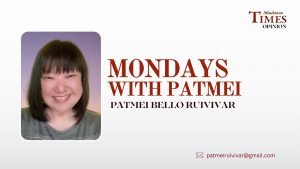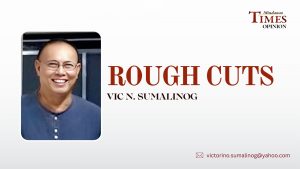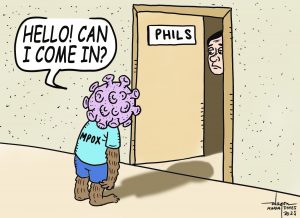The Kadayawan Festival is associated with thanksgiving for our bountiful harvest. August is the season when fruits are in abundance and everyone is out on the streets buying them and eating them together with family and friends.
Last weekend, we drove around with some friends in search of these fruits to share. And though they are still bountiful, they are now more expensive than a few years ago. Gone were the days of abundance when you can visit any farm in Davao and eat all the fruits you can carry.
I miss those days when the sidewalks were overflowing with all kinds of fruits and vendors were practically giving them out to get rid of them. Multicabs, jeepneys, and tricycles filled with fruits would go around the city, park at strategic spots, and slash prices to unload their harvest faster. Because there were more where they came from.
Today, it is almost a luxury to indulge in durian, mangosteen, lanzones, rambutan and marang.
When you ask a vendor why his durian is so expensive, he would now tell you it is because most of our harvest are exported to China now. It turns out China is the world’s largest durian consumer and the Davao market just cannot compare to that.
However, not all durian varieties are exported like our native durian so we can still probably afford that. For now. But what if every durian farmer shifts production to only durian for export?
I am starting to worry that there will come a time when Davao fruits will become as rare and as expensive as the imported fruits. And I hope this is something we should think about and take seriously as a community of fruit-loving people.
Another noticeable absence in our Kadayawan Festivals of late are the orchids and other ornamental plants. Where are they now? They used to be everywhere especially during this time of the year.
I remember when Davao’s tagline was “City in Bloom” and almost everyone coming from Davao will be carrying waling-waling orchids to bring home as “pasalubong” or gifts.
Our floral float parade was a big attraction with big floats decorated exclusively with fresh flowers and other ornamental plants. In recent years, floats have become smaller and fewer because fresh flowers seem harder to source now. And the floral floats now contain other things not just fresh flowers.
We used to have showcases of beautiful floral landscapes at the Agri-Industrial Fair every Kadayawan along with bonsai exhibits. I miss those events.
I thought we would have more of those after the pandemic since many Davaoeños have become “plantitos” and “plantitas” during those times when we all were forced to stay at home.
Our creativity was in full display when we were all in lockdown. Remember the “Cluster Wars” we had when we were able to compose catchy and meaningful songs and choreograph fantastic dance moves that we all shared online?
So I was kind of hoping that will be back in a most fabulous way when we will celebrate our Kadayawan face-to-face. I thought after the hiatus, our creative energies will overflow during Sayaw Mindanao, Tunog Mindanao, and Moda Mindanao. But I have not seen them make a comeback this festival season.
Instead, most of the events we have seen lately are concerts by pop artists from the national capital. Why? Where is that abundance of creativity from Davao talents?
We can have these popular artists any time of the year. Why are they our main attraction at San Pedro Square when we are celebrating our indigenous heritage and abundant harvest?
Yes, our indigenous tribes have a home at the cultural village at Magsaysay Park where they also showcase their music and dances and products. But I believe during Kadayawan they should be everywhere occupying our streets and dominating our senses.
I remember when local radio and television stations would play Kadayawan music all festival long. Hotels and restaurants would all have their own cultural showcases. All shopping malls had live kulintangan, indak-indak, and colorful festival decors. The entire city, at least the downtown area, was festive and giving off Davao’s multicultural vibe.
It’s like Christmas, but Kadayawan. It’s colorful, festive, and loud. A true celebration.
I also miss the focus on stewardship and caring for our environment during the festival. It is a cherished Davaoeño value of being deeply connected to nature, something we inherited from our indigenous communities.
Back in the day, we usually started the Kadayawan Festival in our precious Davao River, where life in Davao started. The various tribes would come on board their decorated river floats and dock by the side of the river where the Tionko football field is located near the bridge. There all the tribal leaders would gather to bang the festival agong to signify the start of the celebration.
It’s reliving the time when our different tribes first arrived in Davao and reminding everyone that we are all connected. It’s also raising awareness on the importance of our water resources because water is life, after all, and Davao has the best water in the world.
Caring for our natural resources is a significant theme every Kadayawan. We will only have a bountiful harvest if we take care of our environment. I think we need to bring that back for the new generation if we are serious about promoting sustainable development.
For Davao City to continue to have a bountiful harvest that will benefit all Davaoeños, we must look at our policies and programs again if they are still relevant to the changing times. Are we doing everything we can to support our farmers and food producers? Are our food and water healthy, accessible, and affordable to all? Does our horticulture industry need help? Are we promoting our local culture enough? Do we need to invest more in our local artists and performers? Is the life we want still here?
Change is good. Innovation is good. Doing something to promote tourism is also good. But that change, that innovation must benefit not just a few. It must benefit all. Not some of the people some of the time. But all of the people all of the time.




